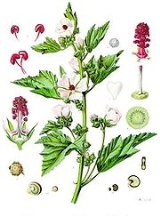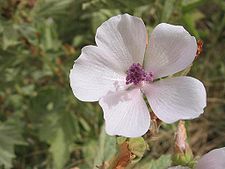
Althaea officinalis
Encyclopedia
Althaea officinalis is a species indigenous to Africa
, which is used as a medicinal plant and ornamental plant
. A confection made from the root since ancient Egyptian time evolved into today's marshmallow
treat.
, are roundish, ovate-cordate, 2 to 3 inches (76.2 mm) long, and about 1 1/4 inch broad, entire or three to five lobed, irregularly toothed at the margin, and thick. They are soft and velvety on both sides, due to a dense covering of stellate hairs. The flowers are shaped like those of the common Mallow, but are smaller and of a pale colour, and are either axillary, or in panicles, more often the latter.
The stamens are united into a tube, the anthers, kidney-shaped and one-celled. The flowers are in bloom during August and September, and are followed, as in other species of this order, by the flat, round fruit which are popularly called 'cheeses.'
The common Mallow is frequently called by country people 'Marsh Mallow,' but the true Marsh Mallow is distinguished from all the other Mallows growing in Great Britain
, by the numerous divisions of the outer calyx (six to nine cleft), by the hoary down which thickly clothes the stems and foliage, and by the numerous panicles of blush-coloured flowers, paler than the Common Mallow. The roots are perennial, thick, long and tapering, very tough and pliant, whitish yellow outside, white and fibrous within.
The whole plant, particularly the root, abounds with a mild mucilage
, which is emollient to a much greater degree than the common Mallow. The generic name, Althaea, is derived from the Greek altho (to cure), from its healing properties. The name of the family, Malvaceae
, is derived from the Greek malake (soft), from the special qualities of the Mallows in softening and healing.
Most of the Mallows have been used as food, and are mentioned by early classic writers with this connection. Mallow was an esculent vegetable among the Romans; a dish of Marsh Mallow was one of their delicacies. Prosper Alpinus stated in 1592 that a plant of the Mallow kind was eaten by the Egyptians
. Many of the poorer inhabitants of Syria
subsist for weeks on herbs, of which Marsh Mallow is one of the most common. When boiled first and fried with onions and butter, the roots are said to form a palatable dish, and in times of scarcity consequent upon the failure of the crops, this plant, which fortunately grows there in great abundance, is collected heavily as a foodstuff.
althainein, meaning "to heal". In traditional Chinese medicine, Althaea officinalis is known as 藥蜀葵 . It increases the flow of breast milk and soothes the bronchial tubes.
Marshmallow is traditionally used as a treatment for the irritation of mucus membranes, including use as a gargle for mouth and throat ulcers, and gastric ulcers. A study on rats concluded that an extract from the flowers has potential benefits for hyperlipidemia
, gastric ulcers and platelet aggregation.
The root extract (halawa extract) is sometimes used as flavouring in the making of a middle eastern snack called halva
. The flowers and young leaves can be eaten, and are often added to salads or are boiled and fried.
The root has been used since the Middle Ages
in the treatment of sore throat. The later French version of the recipe, called pâté de guimauve (or "guimauve" for short), included an eggwhite meringue
and was often flavored with rose water. Pâté de guimauve more closely resembles contemporary commercially available marshmallow
s, which no longer contain any actual marshmallow.
, β-sitosterol and lanosterol
.

Africa
Africa is the world's second largest and second most populous continent, after Asia. At about 30.2 million km² including adjacent islands, it covers 6% of the Earth's total surface area and 20.4% of the total land area...
, which is used as a medicinal plant and ornamental plant
Ornamental plant
Ornamental plants are plants that are grown for decorative purposes in gardens and landscape design projects, as house plants, for cut flowers and specimen display...
. A confection made from the root since ancient Egyptian time evolved into today's marshmallow
Marshmallow
The marshmallow is a confection that, in its modern form, typically consists of sugar, corn syrup, water, gelatin that has been softened in hot water, dextrose, vanilla flavourings, and sometimes colouring, whipped to a spongy consistency. Some marshmallow recipes call for egg whites...
treat.
Description
The stems, which die down in the autumn, are erect, 3 to 4 feet (1.2 m) high, simple, or putting out only a few lateral branches. The leaves, shortly petioledPetiole (botany)
In botany, the petiole is the stalk attaching the leaf blade to the stem. The petiole usually has the same internal structure as the stem. Outgrowths appearing on each side of the petiole are called stipules. Leaves lacking a petiole are called sessile, or clasping when they partly surround the...
, are roundish, ovate-cordate, 2 to 3 inches (76.2 mm) long, and about 1 1/4 inch broad, entire or three to five lobed, irregularly toothed at the margin, and thick. They are soft and velvety on both sides, due to a dense covering of stellate hairs. The flowers are shaped like those of the common Mallow, but are smaller and of a pale colour, and are either axillary, or in panicles, more often the latter.
The stamens are united into a tube, the anthers, kidney-shaped and one-celled. The flowers are in bloom during August and September, and are followed, as in other species of this order, by the flat, round fruit which are popularly called 'cheeses.'
The common Mallow is frequently called by country people 'Marsh Mallow,' but the true Marsh Mallow is distinguished from all the other Mallows growing in Great Britain
Great Britain
Great Britain or Britain is an island situated to the northwest of Continental Europe. It is the ninth largest island in the world, and the largest European island, as well as the largest of the British Isles...
, by the numerous divisions of the outer calyx (six to nine cleft), by the hoary down which thickly clothes the stems and foliage, and by the numerous panicles of blush-coloured flowers, paler than the Common Mallow. The roots are perennial, thick, long and tapering, very tough and pliant, whitish yellow outside, white and fibrous within.
The whole plant, particularly the root, abounds with a mild mucilage
Mucilage
Mucilage is a thick, gluey substance produced by most plants and some microorganisms. It is a polar glycoprotein and an exopolysaccharide.It occurs in various parts of nearly all classes of plant, usually in relatively small percentages, and is frequently associated with other substances, such as...
, which is emollient to a much greater degree than the common Mallow. The generic name, Althaea, is derived from the Greek altho (to cure), from its healing properties. The name of the family, Malvaceae
Malvaceae
Malvaceae, or the mallow family, is a family of flowering plants containing over 200 genera with close to 2,300 species. Judd & al. Well known members of this family include okra, jute and cacao...
, is derived from the Greek malake (soft), from the special qualities of the Mallows in softening and healing.
Most of the Mallows have been used as food, and are mentioned by early classic writers with this connection. Mallow was an esculent vegetable among the Romans; a dish of Marsh Mallow was one of their delicacies. Prosper Alpinus stated in 1592 that a plant of the Mallow kind was eaten by the Egyptians
Egyptians
Egyptians are nation an ethnic group made up of Mediterranean North Africans, the indigenous people of Egypt.Egyptian identity is closely tied to geography. The population of Egypt is concentrated in the lower Nile Valley, the small strip of cultivable land stretching from the First Cataract to...
. Many of the poorer inhabitants of Syria
Syria
Syria , officially the Syrian Arab Republic , is a country in Western Asia, bordering Lebanon and the Mediterranean Sea to the West, Turkey to the north, Iraq to the east, Jordan to the south, and Israel to the southwest....
subsist for weeks on herbs, of which Marsh Mallow is one of the most common. When boiled first and fried with onions and butter, the roots are said to form a palatable dish, and in times of scarcity consequent upon the failure of the crops, this plant, which fortunately grows there in great abundance, is collected heavily as a foodstuff.
Traditional uses
The leaves, flowers and the root of A. officinalis (marshmallow) all have medicinal properties. These are reflected in the name of the genus, which comes from the GreekGreek language
Greek is an independent branch of the Indo-European family of languages. Native to the southern Balkans, it has the longest documented history of any Indo-European language, spanning 34 centuries of written records. Its writing system has been the Greek alphabet for the majority of its history;...
althainein, meaning "to heal". In traditional Chinese medicine, Althaea officinalis is known as 藥蜀葵 . It increases the flow of breast milk and soothes the bronchial tubes.
Marshmallow is traditionally used as a treatment for the irritation of mucus membranes, including use as a gargle for mouth and throat ulcers, and gastric ulcers. A study on rats concluded that an extract from the flowers has potential benefits for hyperlipidemia
Hyperlipidemia
Hyperlipidemia, hyperlipoproteinemia, or hyperlipidaemia is the condition of abnormally elevated levels of any or all lipids and/or lipoproteins in the blood...
, gastric ulcers and platelet aggregation.
The root extract (halawa extract) is sometimes used as flavouring in the making of a middle eastern snack called halva
Halva
Halva refers to many types of dense, sweet confections, served across the Middle East, South Asia, Central Asia, West Asia, North Africa, the Horn of Africa, the Balkans, Eastern Europe, Malta and the Jewish world.The term halva ,...
. The flowers and young leaves can be eaten, and are often added to salads or are boiled and fried.
The root has been used since the Middle Ages
Middle Ages
The Middle Ages is a periodization of European history from the 5th century to the 15th century. The Middle Ages follows the fall of the Western Roman Empire in 476 and precedes the Early Modern Era. It is the middle period of a three-period division of Western history: Classic, Medieval and Modern...
in the treatment of sore throat. The later French version of the recipe, called pâté de guimauve (or "guimauve" for short), included an eggwhite meringue
Meringue
Meringue is a type of dessert made from whipped egg whites and sugar, occasionally some recipes may call for adding an acid such as cream of tartar or a small amount of vinegar and a binding agent such as cornstarch found in icing sugar which may be added in addition to the corn starch which...
and was often flavored with rose water. Pâté de guimauve more closely resembles contemporary commercially available marshmallow
Marshmallow
The marshmallow is a confection that, in its modern form, typically consists of sugar, corn syrup, water, gelatin that has been softened in hot water, dextrose, vanilla flavourings, and sometimes colouring, whipped to a spongy consistency. Some marshmallow recipes call for egg whites...
s, which no longer contain any actual marshmallow.
Chemistry
Chemical constituents include altheahexacosanyl lactone (n-hexacos-2-enyl-1,5-olide), 2β-hydroxycalamene (altheacalamene) and altheacoumarin glucoside (5,6-dihydroxycoumarin-5-dodecanoate-6β-D-glucopyranoside), along with the known phytoconstituents lauric acidLauric acid
Lauric acid , the saturated fatty acid with a 12-carbon atom chain, is a white, powdery solid with a faint odor of bay oil or soap.-Occurrence:...
, β-sitosterol and lanosterol
Lanosterol
Lanosterol is a tetracyclic triterpenoid, which is the compound from which all steroids are derived.-Role in creation of steroids:Elaboration of lanosterol under enzyme catalysis leads to the core structure of steroids. 14-Demethylation of lanosterol by CYP51 eventually yields...
.


